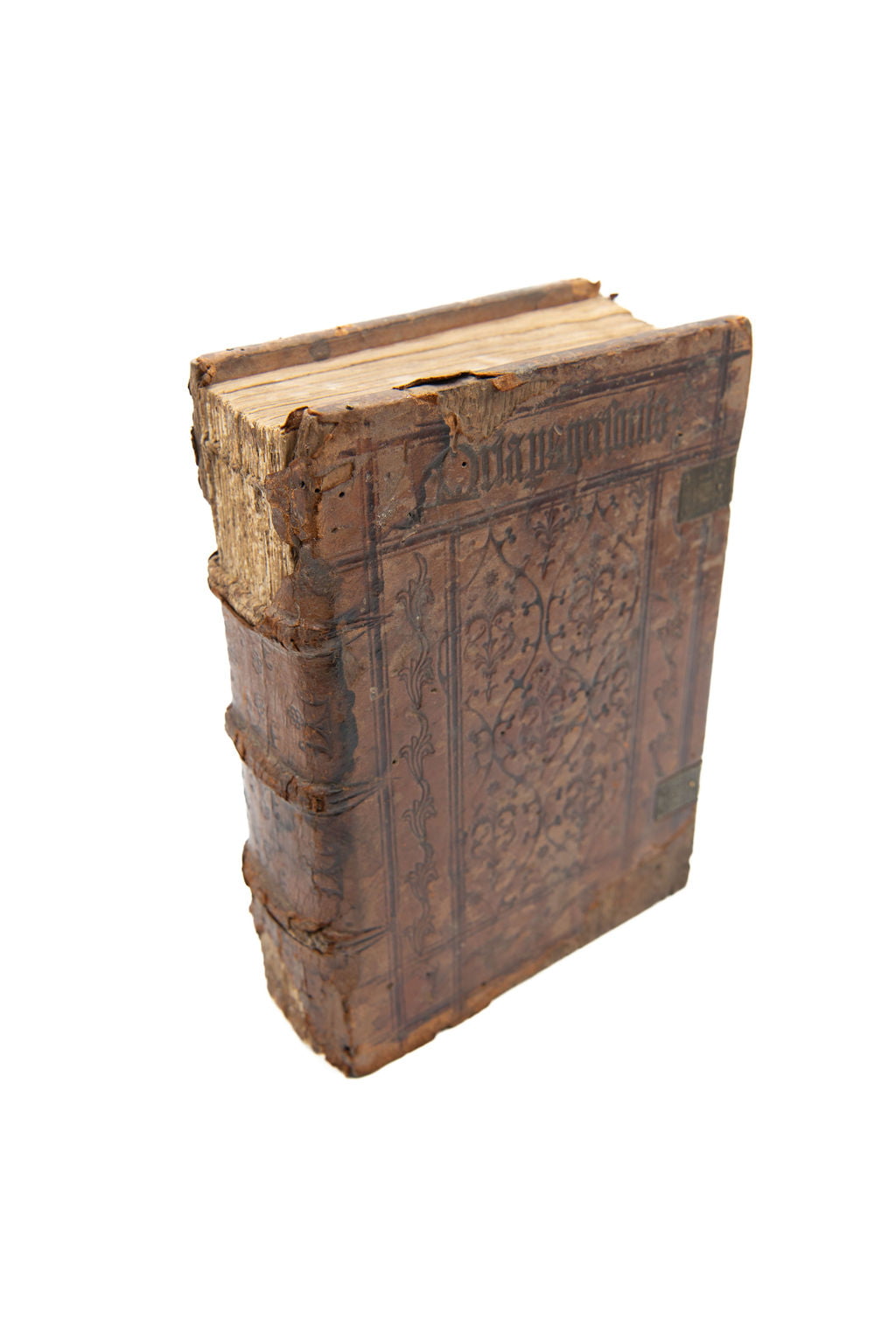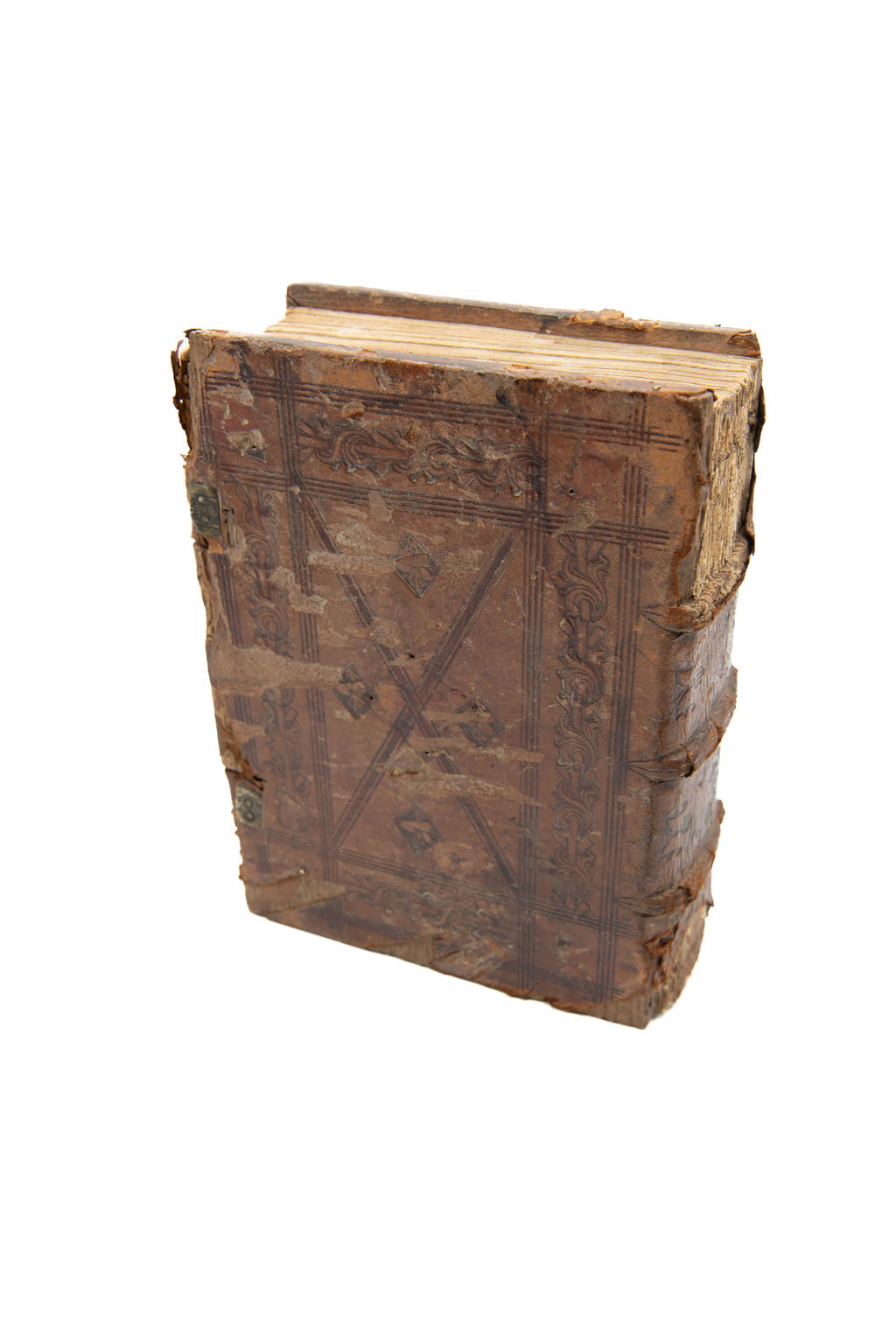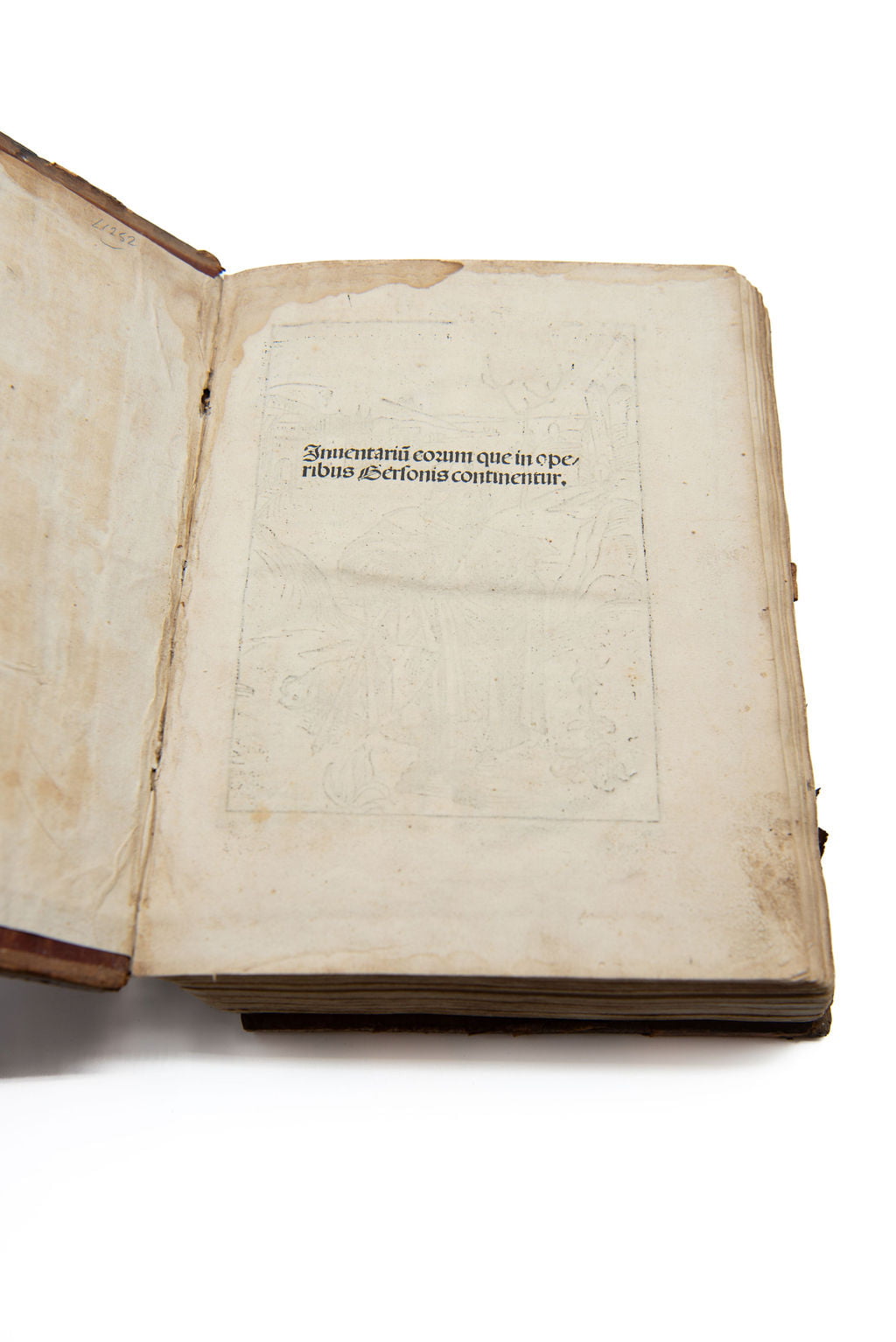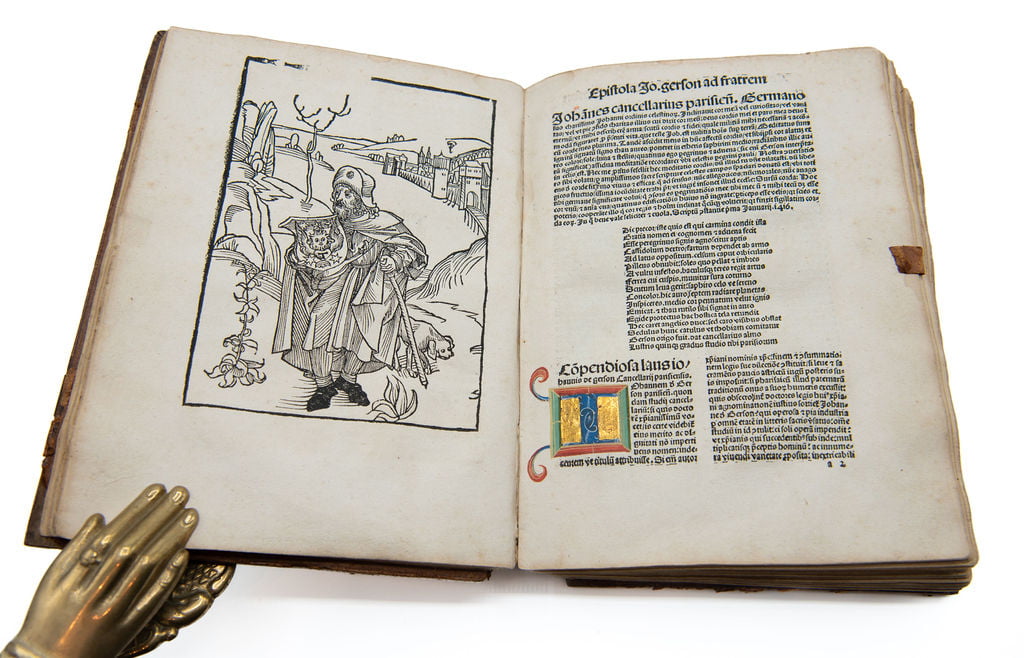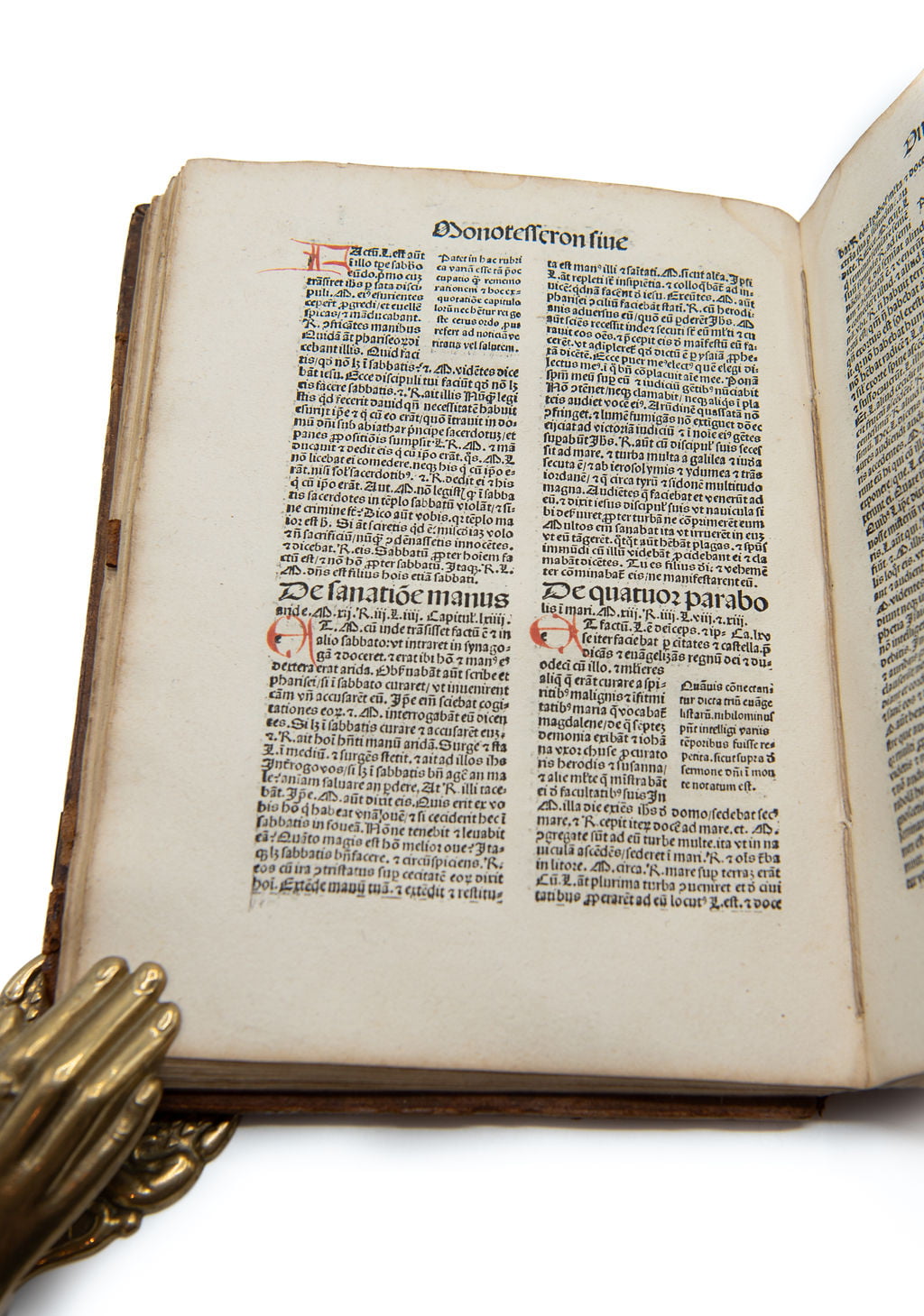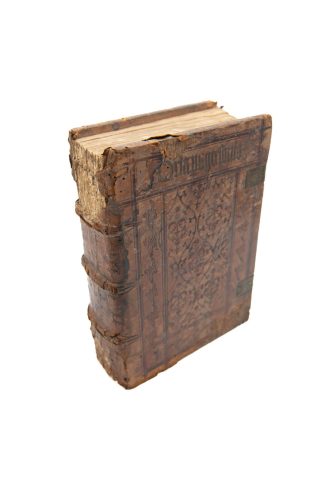GERSON, Johannes
Opera: Inuentarium eorum que in operibus Gersonis continentur [with] Prima pars operum Oohannis Gerson
[Nürnberg], [Georg Stuchs], 1489£12,500.00
4to (2 parts in 1) 52 unnumbered leaves, A–E , F12. + 240 unnumbered leaves, in double column, a–r , f , s-u , v, w, x-z , , , , . Gothic letter. Capitals supplied in red and blue, some with flourishes, superb full page woodcut attributed to Albrecht Dürer, of the author as pilgrim on verso of both titles, large painted initial I in blue with white penwork on liquid gold ground, with green and red borders and blue and red flourishes with yellow penwork, (recto of A2) leather tab on second title. Light age yellowing, rare marginal thumb marks or stains, small worm trail in blank inner margin of two quires, small water stain at blank inner and upper margin of first few ll., a little more extensive at end. A very good copy, crisp and clean on thick high quality paper, with good margins, and strong impressions of the woodcuts, in a lovely contemporary South German binding of deerskin over thick wooden boards, covers triple blind ruled to a panel design, upper cover with outer panel of repeated floral blind tools with author and title stamped at head, central panel filled with curved branches and floral tools, lower cover with floral tools to outer panel, central panel with four diagonal compartments each with a blind-stamped ‘pierced heart’ tool, spine with three blind ruled raised bands, floral tools blind-stamped in compartments, brass catches stamped with initials IGU and hound, lacking clasps and central bosses, head and tail of spine defective exposing stitching, extremities worn, rubbed.
A lovely copy of the first book of the fourth edition of Jean Gerson’s works, edited by Peter Schott and Johann Geiler von Kaysersberg, bound with the most useful, and often missing, index to the complete works. The beautiful woodcut, repeated on both titles, has been attributed to A. Durer, when he was still an apprentice, by W.L. Strauss, ‘Albrecht Durer Woodcuts and Woodstocks’, New York 1980. Durer certainly produced, at a later date, another more elaborate version of this image, with exactly the same composition. Gerson is often portrayed as a pilgrim as he was forced to flee France after the Council of Constance to Rattenberg in Tyrol. Jean Gerson, chancellor of the University of Paris, was one of the most influential theologians of the fifteenth century. He worked to resolve the Great Schism and played an important role at the Council of Constance, where he influenced the decisions concerning the fate of the Hussites. His extensive writings on ecclesiology, reform, pastoral care and mysticism were popular during the later Middle Ages and were frequently printed during the second half of the fifteenth century, both as individual treatises and in collected editions. This first vol. contains some of his most important work, especially his ‘De unitate Ecclesiae,’ and the work in which Gerson set down his most mature reflections on the conciliar question, the ‘Tractatus de potestate ecclesiastica et origine juris et legum’, a treatise on ecclesiastical power and on the origin of right and laws. “the common opinion on Gerson, established by Tierney, argues that he established a modern theory of natural rights in connection with conciliarism,” Gladden J. Pappin. The vol also includes most of his works concerning magic, astrology, and visions such as the important and hugely influential treatises ‘Trilogium Astrologie theologistate,’, ‘De libris astrologicis non tolerandis’, ‘De Probatione Spirituum’, ‘De distinctione verarum visionum a falsis’, and ‘De erroribus circa artem magicam’ and also includes his essay against the sect of the Flagellants. Gerson explicitly lamented at the beginning of De erroribus circa artem magicam that superstitious observances in Europe were growing ever more prevalent, and in 1398 the theological faculty of the university at Paris issued a decree condemning twenty-eight articles of magical arts and sorcery. Gerson then produced these several brief works criticizing various forms of superstition and magic. To the first of these, ‘De erroribus circa artem magicam’ 1402, half of which is devoted to questions of demonic existence and power, he appended the list of the 1398 condemnations, which he had helped orchestrate, and he also includes the complete text of the confession of ‘Jean de Bar’, who was accused of necromancy, and condemned to death. His treatise, ‘De Distinctione Verarum Visionum a Falsis’, dealt with ‘discretione spirituum’ (“the discernment of spirits”) and sought to lay out methods for determining whether a mystical vision was true or false, orthodox or heretical, inspired by God or by the Devil. At the Council of Constance, in 1415, he was called on to help decide whether or not Bridget of Sweden’s visions were authentic. He felt they were not and wrote another treatise, ‘De Probatione Spirituum’, which set out principles and procedures for distinguishing good spirits from evil ones in visions. He was also consulted by Charles VII on Jeanne d’Arcs visions. The charming South German binding is very similar in design and in its tools to one in Henry Davis Gift, Vol. II 325, though produced on a larger scale. A lovely copy of this important and beautifully produced incunable.
Not in BMC. ISTC ig00188000. GW10716. Goff G188. HC 7623. Polain(B) 1592. Bod-inc G-087;In stock


